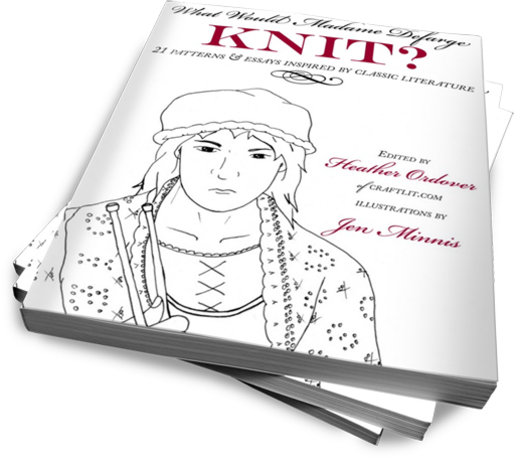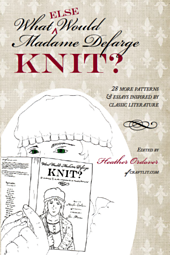Homework - six hour class
YARN: Use your stash for the
socklettes. Whatever weight you want; whatever color you want (though it's easier to see stitches in lighter colors). The closer to worsted you are, the faster the heels go, but you'll compromise a bit on fit. The finer the yarn, the slower you go, but you'll get a dead-on accurate fit.
If you only have enough scrap sock yarn to make one heel, switch up and do the next one in DK or worsted. Some heels work better in a heavier weight so it won't damage your success at all. We'll make it work.
NEEDLES: Match the needles to your yarn and your preferences. You are more than welcome to use DPNs, Magic Loop, or 2 Circs.
NOTIONS to BRING: snippy scissor or yarn cutter and a darning needle that fits your yarn. Paper worksheets will be provided, but you may want to have a notebook with you. Pens are fine but you may want a pencil with an eraser (we're doing math, so...well...my eraser is my friend). Feel free to use a calculator—I often do.
HOMEWORK: For the three hour class, you will want to make at least one, preferably three, socklettes. For the six hour class, you will want to make at least three, preferably six,
socklettes.
What's a socklette?
It is a little sock that looks like a tennis sock, just barely touching the ankle, but it ends after the gusset. This way you have a heel you can try on, but not something that takes weeks to knit.
You will need the following for the six hour class:
| Knit Three |
Knit One |
Knit Two |
- Cast on enough stitches to fit around your ankle in your yarn at your gauge (roughly 40ish+ for worsted, 64ish+ for DK). Be sure at least one socklette is in sock-weight yarn at around 64-72 sts for your cast-on*.
- K2P2 rib for an inch or more (this is the ankle part of your socklette).
- Place half of your stitches on a holder (rigid or scrap yarn—your call)
- (RS) Sl 1, K1 across, ending with a K1. Turn.
- (WS) Sl 1, Purl across.
- Repeat these two rows for as many rows as you have stitches (32 stitches being worked=32 rows)
- Stop!
- Put these stitches on a holder (or keep them on the needle if you have enough to spare).
|
- Cast on as before.
- K2P2 rib for an inch or more (this is the ankle part of your socklette).
- Count half of your stitches. Take that number (H) and add 8. H+8 will be the total number of working stitches for the heel flap. The remainder will go onto the holder for the instep.
- (Cast-on 40: work heel on 28.
Cast-on 64: work heel on 40.)
- (RS): slip 1 purlwise, k3, [slip 1, k1] to last four stitches, p2k2, turn.
- *(WS): slip 1, purl to end, turn.
- (RS): slip 1, k1p2, [slip 1, k1] to last 4 sts, p2k2, turn.*
- Repeat last two rows for half (H) of your total stitches (cast-on 40: work 20 rows; cast-on 64: work 32 rows). If your heel is tall you may prefer working H+8 rows.
- Stop!
- Put these stitches on a holder (or keep them on the needle if you have enough to spare).
|
- Cast on as before, preferably with light-worsted or worsted yarn (for faster work in class).
- K2P2 rib for an inch or more (this is the ankle part of your socklette).
- Stop!
- These cuffs will use non-flap heel techniques in class.
- Put these stitches on a holder (or keep them on the needle if you have enough to spare).
|
*one sock relies on having a larger number of stitches for the turn.
From these humble beginnings we will create up to six masterful and completely different heels. Heels you can try on (and use as pedicure socks!) and walk around in to see which fits you best. The worksheets provided guarantees that you will be able to substitute the right heel for you foot into any pattern you choose to knit.
^return to top
Homework - three hour class
YARN: Use your stash for the
socklettes. Whatever weight you want; whatever color you want (though it's easier to see stitches in lighter colors). The closer to worsted you are, the faster the heels go, but you'll compromise a bit on fit. The finer the yarn, the slower you go, but you'll get a dead-on accurate fit.
If you only have enough scrap sock yarn to make one heel, switch up and do the next one in DK or worsted. Some heels work better in a heavier weight so it won't damage your success at all. We'll make it work.
NEEDLES: Match the needles to your yarn and your preferences. You are more than welcome to use DPNs, Magic Loop, or 2 Circs.
NOTIONS to BRING: snippy scissor or yarn cutter and a darning needle that fits your yarn. Paper worksheets will be provided, but you may want to have a notebook with you. Pens are fine but you may want a pencil with an eraser (we're doing math, so...well...my eraser is my friend). Feel free to use a calculator—I often do.
HOMEWORK: For the three hour class, you will want to make at least one, preferably three, socklettes.
What's a socklette?
It is a little sock that looks like a tennis sock, just barely touching the ankle, but it ends after the gusset. This way you have a heel you can try on, but not something that takes weeks to knit.
You will need the following for the three hour class:
| Knit Two |
Knit One |
- Cast on enough stitches to fit around your ankle in your yarn at your gauge (roughly 40ish+ for worsted, 64ish+ for DK). Be sure at least one socklette is in sock-weight yarn at around 64-72 sts for your cast-on*.
- K2P2 rib for an inch or more (this is the ankle part of your socklette).
- Place half of your stitches on a holder (rigid or scrap yarn—your call)
- (RS) Sl 1, K1 across, ending with a K1. Turn.
- (WS) Sl 1, Purl across.
- Repeat these two rows for as many rows as you have stitches (32 stitches being worked=32 rows)
- Stop!
- Put these stitches on a holder (or keep them on the needle if you have enough to spare).
|
- Cast on as before.
- K2P2 rib for an inch or more (this is the ankle part of your socklette).
- Count half of your stitches. Take that number (H) and add 8. H+8 will be the total number of working stitches for the heel flap. The remainder will go onto the holder for the instep.
- (Cast-on 40: work heel on 28.
Cast-on 64: work heel on 40.)
- (RS): slip 1 purlwise, k3, [slip 1, k1] to last four stitches, p2k2, turn.
- *(WS): slip 1, purl to end, turn.
- (RS): slip 1, k1p2, [slip 1, k1] to last 4 sts, p2k2, turn.*
- Repeat last two rows for half (H) of your total stitches (cast-on 40: work 20 rows; cast-on 64: work 32 rows). If your heel is tall you may prefer working H+8 rows.
- Stop!
- Put these stitches on a holder (or keep them on the needle if you have enough to spare).
|
*one sock relies on having a larger number of stitches for the turn.
From these humble beginnings we will create up to three masterful and completely different heels. Heels you can try on (and use as pedicure socks!) and walk around in to see which fits you best. The worksheets provided guarantees that you will be able to substitute the right heel for you foot into any pattern you choose to knit.
^return to top







